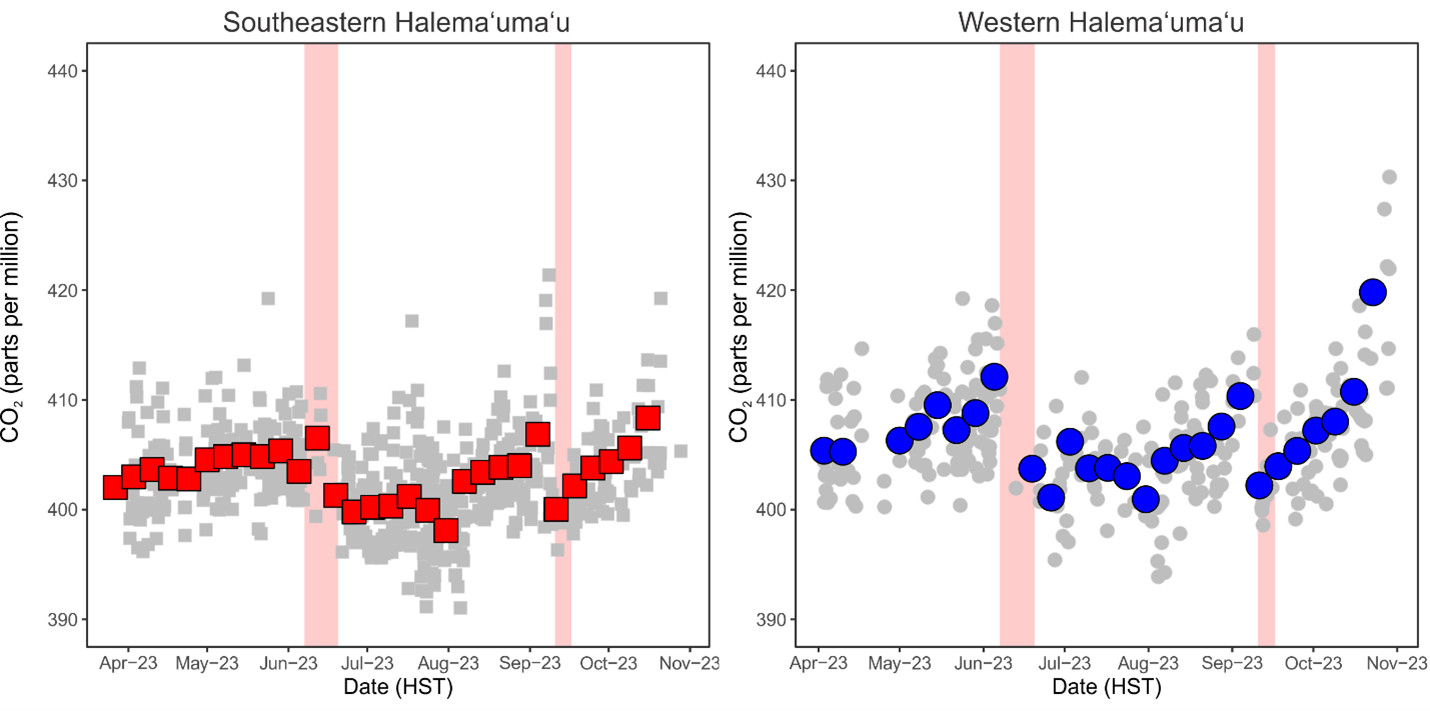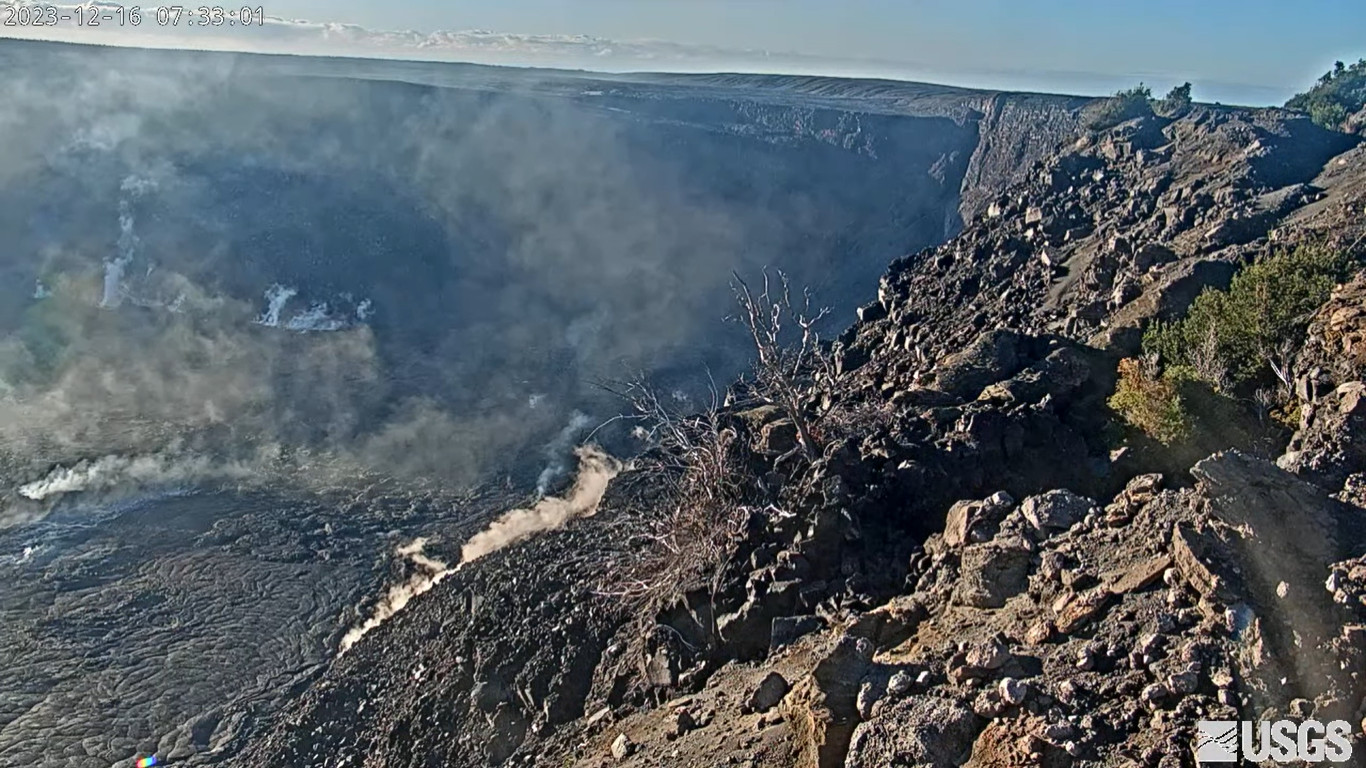(BIVN) – Kīlauea is not erupting, and its USGS Volcano Alert level is ADVISORY.
On Saturday, USGS Hawaiian Volcano Observatory scietists reported that over the past two days, “shallow seismicity in Kīlauea’s summit region has declined slightly, but there has been an increase in the number of deeper earthquakes” located 7 to 9 miles (11 to 15 km) below Kaluapele, the volcano’s summit caldera.
Unrest continues, and scientists say there are currently no signs of an imminent eruption. Sulfur dioxide gas emission rates remain low. “Field measurements indicated an SO2 emission rate of approximately 70 tonnes per day on December 5, which was similar to measurements in October and November,” the USGS HVO Hawaiian Volcano Observatory wrote on Friday.
From this week’s Volcano Watch, written by USGS HVO scientists and affiliates:
Kīlauea has erupted three times in 2023—January–March, June, and September—and has also experienced significant intrusive activity to the southwest of the summit since the beginning of October.
During eruptions, the USGS Hawaiian Volcano Observatory (HVO) frequently reports sulfur dioxide (SO2) emission rates as a means of tracking the progression of eruptive activity. But for the periods before eruptions, or when there is an ongoing intrusion with no eruption, most of the data that HVO relies on is geophysical data, like deformation or seismicity, rather than geochemical data like SO2 emissions.
However, as “Volcano Watch” has discussed before, there is another type of gas that can be important during non-eruptive periods—carbon dioxide (CO2).
CO2 behaves very differently from SO2 in Kīlauea’s magmatic system, and these differences can be exploited to help better understand processes occurring beneath the ground surface. For example, CO2 can begin to escape from Kīlauea’s magma when it is still many kilometers (miles) beneath the surface even though SO2 is largely released when magma is just a few tens or hundreds of meters (yards) beneath the surface. In a practical sense, this often means that we don’t see much SO2 being emitted until lava begins erupting at the surface.
Because CO2 escapes the magma from deeper, we should be able to see changes in the amount of CO2 coming from Kīlauea as magma gets shallower, even if it’s not shallow enough to erupt yet.
The tricky thing about CO2, though, is that it is already present—and highly variable—in the atmosphere. This is different from SO2—SO2 is not normally present in background atmosphere, so it’s easy to pick out a volcanic SO2 signal in ambient air measurements. But atmospheric CO2 can vary over the course of a day, as well as with the seasons. So, picking out a small volcanic CO2 signal from variable amounts in the background atmosphere can be tough, and it has indeed proved difficult over the years at both Kīlauea and Mauna Loa.
Recently, however, in cooperation with colleagues at the USGS Cascades Volcano Observatory, we have been looking a little closer at CO2 data from Kīlauea. We have a multi-GAS station just to the southwest of Halemaʻumaʻu that measures four volcanic gases (CO2, SO2, hydrogen sulfide, and water vapor) as well as meteorological data like wind speed and wind direction. Instead of using all the CO2 data from the multi-GAS, which can be noisy because of background variations in CO2, we separate out CO2 data that reaches the station from certain directions at certain wind speeds. This allows us to try to isolate the volcanic CO2 signal.

USGS: “These plots show provisional CO2 concentrations from two approximate areas at Kīlauea summit, over March–October 2023. Final, quality-assured concentrations will be calculated during post-processing by making small adjustments to the provisional data using measurements of known calibration gases, but the relative trends shown here are real (and are the sum of volcanic signals and variations in background CO2). Red squares and blue circles represent weekly averages of CO2 concentration measured at the Kīlauea multi-GAS station when the wind is coming from specific directions at specific wind speeds. Gray symbols are the individual measurements (30-minute averages up to 8 times per day). Pink vertical bars represent the June and September Kīlauea eruptions.”
What have we seen? Well, the data are still noisy, so instead of looking at individual data points (up to eight per day), we calculate weekly averages of the CO2 concentration. Once we do that, if we look only at data coming from two portions of Halemaʻumaʻu (roughly the western part of the crater and the southeastern part of the crater) at moderate wind speeds, we see patterns in the CO2 concentration relative to the recent summit eruptions.
For both wind directions we look at, we can see that CO2 coming from those directions appeared to increase—slowly and slightly—before the June and September Kīlauea summit eruptions. Once the eruptions occurred, CO2 concentrations dropped back down. Now, since the September eruption, those CO2 concentrations are increasing again, and the increase is likely related to the intrusion of magma into the shallow storage regions beneath the summit and south caldera regions.
Often when Kīlauea erupts, HVO uses the low ratio of eruptive CO2 to SO2 to be able to say that the magma feeding the eruption was stored very shallow because that low ratio tells us the magma already degassed most of its CO2 before eruption. What we’re seeing right now is that pre-eruptive CO2 loss in the form of these CO2 increases before eruptions as magma gets closer to the surface.
The next step with this new data analysis method is to try to turn the CO2 concentration data into emission rates of CO2, which could then perhaps tell us not just that magma is rising to shallow depths beneath Kīlauea, but how much magma is rising.


by Big Island Video News8:32 am
on at
STORY SUMMARY
ISLAND OF HAWAIʻI - In this week's Volcano Watch article, scientists discuss "sniffing out" stealthy gas escape between periods of eruptive activity.